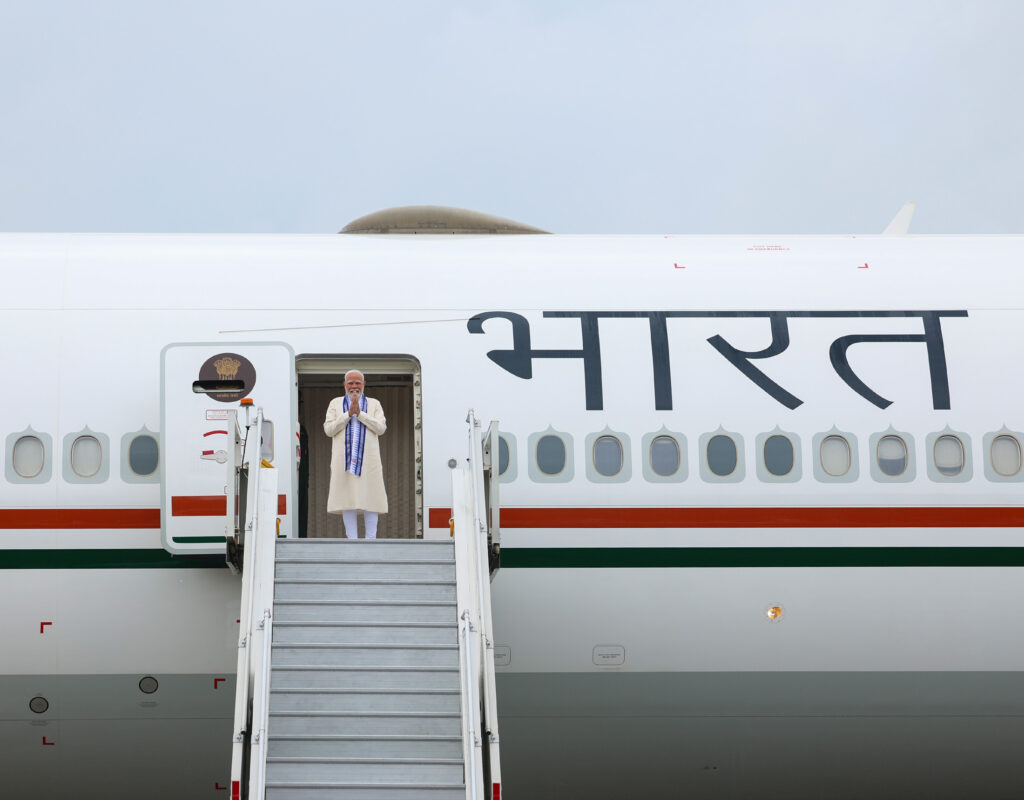Prime Minister Modi’s recent five-nation tour to Ghana, Trinidad and Tobago, Argentina, Brazil, and Namibia was no ordinary diplomatic visit. It was a meticulously planned “diplomatic offensive” designed to secure concrete, pinpointed benefits for India across various critical sectors. This strategic outreach aims to position India for significant economic, technological, and geopolitical advantages in the years to come, moving far beyond mere goodwill.
Ghana: Unlocking West African Opportunities
The visit to Ghana, the first by an Indian Prime Minister in over three decades, signaled a strong re-engagement with West Africa. As a stable democracy and a key member of ECOWAS, Ghana offers India a strategic entry point into the wider West African market. India already stands as Ghana’s top trading partner and the largest destination for Ghanaian exports, with bilateral trade exceeding $2 billion. This tour aimed to further expand trade, increasing Indian exports of pharmaceuticals, automobiles, and machinery to Ghana, while securing crucial imports like gold, which constitutes over 70% of India’s imports from Ghana. This diversification of trade is set to bolster India’s economic resilience. Beyond gold, Ghana’s rich reserves of critical minerals are of immense interest to India’s burgeoning manufacturing and high-tech sectors. Discussions on collaboration in this area are vital for securing a more diverse and reliable supply chain for Indian industries, reducing reliance on a limited number of sources. With deteriorating security in the Sahel region, Ghana’s stability is paramount. India’s expertise in counter-terrorism and its growing defense industry offer avenues for cooperation in training, equipment supply, and defense exchanges. This strengthens regional security, indirectly benefiting India’s broader strategic interests in Africa and global counter-terrorism efforts. India’s success with DPIs like UPI and Aadhaar offers a compelling model for Ghana. Collaboration in this space could lead to the export of Indian technological solutions, establishing India as a leader in digital transformation for the Global South. Continued development assistance, including concessional credit and capacity building programs (like ITEC), strengthens goodwill and creates long-term economic and diplomatic leverage for India.
Trinidad and Tobago: Deepening Diaspora Ties and Caribbean Access
This leg of the tour revitalized India’s connection with the Caribbean, a region home to a significant Indian diaspora. With nearly 40% of Trinidad and Tobago’s population being of Indian origin, the visit reinforced cultural ties and opened avenues for diaspora engagement. This strengthens India’s soft power and cultivates a robust network of advocates for India’s interests abroad. Trinidad and Tobago is a key player in the Caribbean’s energy sector. India’s engagement can lead to enhanced cooperation in oil and gas, potentially securing energy imports or exploring joint ventures in renewable energy. Furthermore, India, a global leader in generic pharmaceuticals, can strengthen its exports of affordable medicines to the Caribbean nation, ensuring access to vital healthcare products while boosting India’s pharmaceutical industry. Trinidad and Tobago’s influence within CARICOM provides India with an entry point to enhance trade and diplomatic ties with the broader Caribbean community, opening up new markets for Indian goods and services.
Argentina: Diversifying Trade and Securing Critical Resources
The visit to Argentina holds significant economic and strategic promise for India, particularly in diversifying its import basket and securing key resources. Argentina is a primary global supplier of edible oils, especially soybean and sunflower oil. Given India’s high import dependence for edible oils, strengthened ties ensure a more stable and cost-effective supply, directly impacting India’s food security and helping control domestic inflation. Argentina is part of the “Lithium Triangle,” holding vast reserves of this critical metal essential for electric vehicles and renewable energy storage. The agreement signed by India’s KABIL (Khanij Bidesh India Ltd.) for leasing lithium blocks is a game-changer, guaranteeing a long-term supply for India’s ambitious e-mobility and green energy targets. This is a crucial step towards self-reliance in cutting-edge industries. India’s engagement in defense manufacturing with Argentina, including the supply of helicopter spares and engine maintenance by HAL, opens doors for India’s burgeoning defense exports to Latin America. Collaboration in space technology and nuclear energy (including small modular reactors) further diversifies India’s strategic partnerships and fosters technological exchange. While edible oils currently dominate imports, the visit aimed to diversify trade. India seeks to increase exports of refined petroleum, motorcycles, pharmaceuticals, and agricultural machinery to Argentina, while exploring imports of other valuable resources like gold and certain cereals.
Brazil: Deepening BRICS Engagement and Energy Security
Brazil, a fellow BRICS member and a significant global economy, is central to India’s multilateral and energy strategies. PM Modi’s participation in the BRICS Summit in Rio de Janeiro and subsequent bilateral talks in Brasília underscored India’s commitment to strengthening this vital platform. This collaboration is crucial for advocating a multipolar world order, reforming global governance, and amplifying the voice of the Global South on issues like climate action, responsible AI, and economic stability. Brazil is a global leader in biofuels. Discussions on bioenergy cooperation, including ethanol blending and second-generation biofuels, are vital for India’s energy transition goals and reducing its fossil fuel dependence. Furthermore, exploring collaborations in oil and gas and renewable energy contributes to India’s overall energy security. Brazil’s interest in India’s growing defense sector, including secure battlefield communication systems, offshore patrol vessels, and missile defense systems, creates significant export opportunities for Indian defense manufacturers. Partnerships with Brazilian aerospace giants like Embraer for joint bids and local supply chain development further integrate India into the global defense industry. Bilateral talks on space collaboration, cybersecurity, and advanced technologies foster knowledge sharing and joint research, propelling India’s technological advancements.
Namibia: Critical Minerals, Conservation, and Strategic Outreach
As the first visit by an Indian Prime Minister to Namibia in recent decades, this leg of the tour signaled India’s expanded focus on Southern Africa. Namibia is a significant producer of diamonds and potentially other critical minerals. India’s engagement aims to ensure a consistent supply of rough diamonds for its world-leading diamond processing industry, thereby sustaining employment and economic activity. Further exploration of other critical minerals bolsters India’s resource security. The visit emphasized collaboration in wildlife conservation, particularly building on the successful reintroduction of cheetahs from Namibia to India. This highlights India’s commitment to global conservation efforts and strengthens scientific cooperation. India’s expertise in IT and education offers avenues for capacity building and skill development in Namibia, aligning with India’s “Development Partnership” model. This creates long-term goodwill and strengthens human resources in Namibia, potentially leading to future economic opportunities for Indian companies. Namibia’s strategic location can serve as a gateway for India to deepen engagement with the Southern African Development Community (SADC), expanding its trade and diplomatic footprint in the region.
Overall Masterstroke: Amplifying India’s Global Influence
Beyond the individual country benefits, the entire five-nation tour represents a masterstroke in India’s foreign policy for several overarching reasons. By proactively engaging with diverse nations across Africa and Latin America, India reinforced its image as a champion of the Global South, advocating for their collective interests on global platforms. This strengthens India’s diplomatic clout and provides a counter-narrative to traditional power blocs. The tour strategically diversified India’s global partnerships, reducing over-reliance on any single region or power. This enhances India’s strategic autonomy and resilience in a complex geopolitical landscape. The relentless focus on investment, trade, energy, and technology translates into tangible economic benefits for India, securing resources, expanding markets for Indian goods and services, and fostering technological advancement. India’s development model, democratic values, and technological prowess were showcased, enhancing its soft power and cultural influence globally. This fosters goodwill and builds long-term relationships based on shared values. By emphasizing cooperation within BRICS, AU, ECOWAS, and CARICOM, India strengthened the very fabric of multilateralism, advocating for a more representative and equitable global order, in which India increasingly plays a leading role. In essence, PM Modi’s five-nation tour was a calculated and comprehensive diplomatic initiative that will significantly contribute to India’s economic growth, energy security, resource acquisition, technological advancement, and geopolitical standing, solidifying its position as a responsible and influential global power.
(The views expressed are the author's own and do not necessarily reflect the position of the organisation)


